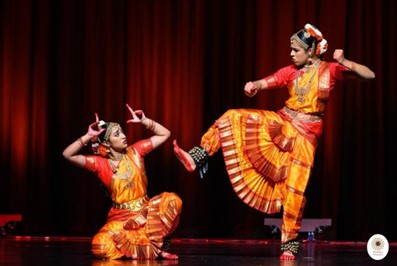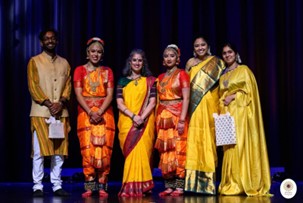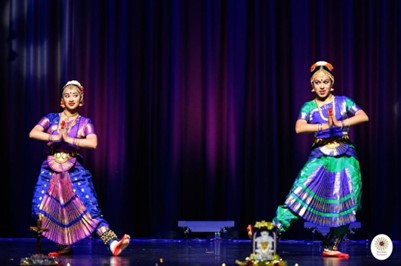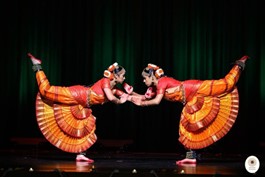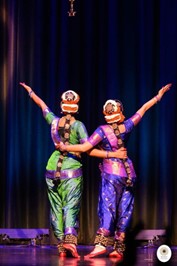Contribute
| Arangetram: Sayontika Battacharya And Annette Varghese |
Anisha Dantam
11/30/2023
Arangetram of
Sayontika Battacharya and Annette Varghese After more than a decade of extensive
training and preparation under Guru Smt. Jayshree Bala Rajamani, the day that
Sayontika and Annette ascend the stage has arrived. On July 8th at Littleton
High School, family and friends gathered to witness a unique Arangetram that
would be a world premiere, yet also a fulfillment of a Guru’s dream to use the
art style of Bharathanatyam to showcase the beauty of all the religions of the
world. With Sayontika being a Bengali Hindu and Annette being a Malayali
Christian, this Arangetram was a dedication to this ultimate concept,
especially through three of their dances: the Mallari, the Murase Varnam, and
the Krishna Yesu Padam, all specially composed by Vidushi Sudha Raghuraman of
Delhi, India, for this particular occasion. With the musical support of their
Guru on Nattuvangam, Smt. Harini Darbha on vocal, Smt. Sushmitha Ravikumar on
violin, and Kumar Hariharan Shanmugham on Mridangam, these two students from
the Barthakalai School of Dance were more than ready for their marvelous
presentation. Sayontika and Annette commenced their
spiritual journey with the Mallari, which is an invocational piece where the
dancers salute Christ in the Lord’s prayer.
Both dancers manifested extreme talent in this piece and executed it
with ease, despite its varying tempos and speeds, and their swift, yet
graceful, footwork and effortless synchronization immediately kindled the
attention of the audience. Next, they steadily transitioned into the Alarippu, however, preserving the theme of
celebrating two religions, this was not the typical Alarippu. This specially choreographed composition was a representation of the forms of worships
in the Hindu and Christian religions with respect to the five
senses,starting with the sight through diyas and candles; the sound of ringing
bells and playing of the conch in the Hindu temple and the playing of the
trumpets in the Christian church; the smell of incense in Hinduism and in a
Christian church; the touch of applying sandal paste or ash on the forehead:
and receiving the holy water and dipping the bread in wine for taste. Sayontika
and Annette displayed very complex steps along with steadfast technique in this
Alarippu while opening their bodies to spiritual release in the likes of a
blossoming flower. Next, Sayontika and Annette continued with
a pure dance piece known as the Jathiswaram, which is intertwined with rhythmic
patterns and melodic notes that requires much exertion. However both dancers
flawlessly executed the various jathi sequences, nailing the rapid footwork. In
addition to this, their expressive abilities were tested by the following
dance, the Shabdam in praise of Lord Nataraja. They fascinated the audience
with their depictions of the young Nayika entranced by Lord Nataraja’s dance in
the temple of Thillai and her flourishing affection for the Lord. With their
impeccable storytelling, it seemed that the audience did not see them as
dancers portraying characters but as the characters themselves. Next, they proceeded on to the most
sensational composition of the event: the Murase Varnam. The Varnam is by far
the longest and most strenuous piece in the Arangetram, however this Varnam was
especially crafted for this Arangetram in particular so that Sayontika and
Annette could share their experience and their religious origins. Both dancers
narrated the four stories with so much ease that it seemed like the
audience was experiencing history right beside them and they completed the
intertwined jathis with astounding swiftness and coordination. After a brief intermission, Sayontika and
Annette resume the performance with the famous Aigiri Nandini to illustrate the
strength and power of the warrior Goddess Durga, prominent in Sayontika’s Bengali
culture. This was demonstrated with much vigor and intense
fervor and both dancers mastered the representation
of the demonic forces with their rage-filled and bold eye movements. Their
ferocity was enhanced by their showcase of the battle between Durga and the
demon, Mahishasura, and the unforgettable concluding pose of the demon’s
gruesome defeat inflicted by the strike of Devi’s trident, which certainly left
the audience in awe. Sayontika and Annette then presented a
unique dance that reconstructs the reputation of the snake; from a reviled and
feared creature to a pure, holy life form that attains salvation when atop Lord
Shiva’s head, the adornment of his beloved consort Parvathi, and the protector
of Krishna from the elements. The dance was performed with utmost poise and
their embodiment of a snake with the flexibility and wave-like motions in
addition to their menacing glares was extraordinary. The union of Sayontika's
unmatched, effortless agility and Annette’s ethereal technique and energy
undoubtedly revived the snake as a whole. The dancers advanced with what was another
world premiere: a Krishna Yesu Padam. Derived from the lyrics of a Bengali
Rabhindra Sangeet and verses from the Bible in Malayalam, the piece emphasized
the similarities between the life of Krishna from Hinduism and Jesus from
Christianity. Sayontika mesmerized the audience with her exhibition of the
majestic birth of Krishna, the lord’s battle with his evil uncle, Kamsa, and
his counseling of Arjuna to eliminate evil and bring back peace. Similarly,
Annette’s representation of Jesus’s blissful birth, his urgence for merchants
to pray to God, and the transition from the Lord’s crucifixion to his
resurrection as a savior was truly captivating. The piece ended with a stanza
from the Mahabharatha conveying that when there is evil and when holy men are
troubled, divine force will establish righteousness. Through this, Sayontika
and Annette surely moved the audience, as it invoked a beautiful sensation of
unity among different religions as one. Finally, Sayontika and Annette reached the
last two items of their Arangetram repertoire: the Thillana followed by the
Manglam, a prayer to all of the world’s religions. The Thillana, a pure dance
piece composed of complex, rapid footwork and exuberant choreographies, was
performed with immense ecstasy and scintillating smiles on both of the dancer’s
faces as they praised the ever-righteous Lord Rama. The fact that Sayontika and
Annette were able to endure through this challenging piece despite it being the
finale of an undeniably arduous performance lasting several hours genuinely
proves not only their unwavering resilience and stamina but also the strength
of their spirits. The standing ovation that erupted from the
audience after the conclusion of the Mangalam was unquestionably deserved, as
Sayontika and Annette spent toilsome hours and effort to make such a successful
event flourish. In a reflection of their Arangetram journey, Sayontika says, “The past ten years have been amazingly
affected by my dance journey. Not
only did it bring me closer to my heritage, it also allowed me to explore the
dance form of Bharatnatyam. I am so grateful for being able to do an
Arangetram, and hope to carry the experiences with me for the rest of my dance
journey!†Annette asserts, “As a bharatanatyam dancer, completing my Arangetram was joyful and momentous. My
Arangetram made me push the boundaries of what I thought I was capable of, and
I learned more about myself through it. I am especially grateful to my dance
teacher for collaborating with me to create a truly unique Arangetram that
combines two different religions! It was an honor to perform something so
unique and personal!†This world premiere was an honor of Guru Smt. Jayshree
Bala Rajamani’s dream to deliver this beautiful religious concept and it is
with her outstanding choreography that Sayontika and Annette have definitely
made it shine. From what was witnessed on this day, the cohesion of not only Hinduism and Christianity, but all of the religions in
the world should be embraced and celebrated. “It does not matter if one is a
Muslim praying to all the four directions, a Hindu praying to an idol, a
Christian reading from the Bible, or a Jew reading from the Torah.†In the past, there have been many
disputes over whether a religion is more righteous than the other or if it is
seen as different from the rest, but this Arangetram has given enlightenment to
a new perception: that everyone shares one common goal regardless of the
religion. Whether praying to a mother that purges evil or a father that
eliminates suffering, we all walk on one common path toward spiritual goodness
and happiness.
You may also access this article through our web-site http://www.lokvani.com/

